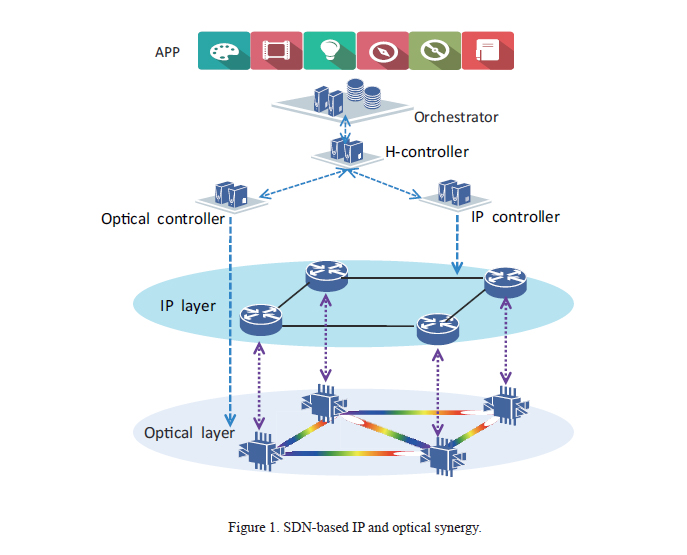Improving SDON Capability with Open and Converged ODL Platform
The Need for Software Defined Optical Networks
With the rapid development of telecom networks, traditional network architecture is facing the challenges of scalability, adaptability, and security. All parties in the industry have been actively involved in network architecture reconstruction, aiming to build open, converged, innovative networks with new technologies, new structure and new services. As the basis of telecom networks, WDM/OTN is also facing the challenges brought by new service types and models. WDM/OTN needs to not only meet the increasing bandwidth demands, but also to rise to the challenges of dynamic service changes, reduced operation costs, and value-added network functions.
With the emergence of beyond- 100G technologies, the spread of open, programmable network resources, and the growth of transmission rates (from 10 Gbps, 40 Gbps, 100 Gbps, to beyond 100 Gbps) and resource attributes (bandwidth granularity, modulation mode, spectrum width, and the number of carriers), WDM/OTN resources have to be effectively optimized, managed, and controlled.
In response to these needs, optical networks urgently need to be software defined, so that operators can schedule and assign WDM/OTN resources in a flexible manner and offer quality transport services to fulfill the need of diverse network service development.
SDON Solution and Application
Based on the ODL platform, ZTE has developed its ZENIC software defined optical network (SDON) controller for WDM/OTN transport. The SDON controller provides WDM/OTN system products with an open, elastic, efficient, and intelligent optical network solution.
The SDON controller based on the hierarchical architecture facilitates operators to manage devices from multiple vendors in a unified manner and to implement service-oriented end-to-end connection configuration. In this way, the integration difficulties in the traditional OSS are resolved and networks that are provided by different vendors and located in different domains are interconnected. For the IP and optical networking scenario, SDN-based architecture enables resource optimization and synergy control for IP and optical layers (Fig.1). This alleviates the load of backbone routers and the pressure of capacity expansion, and reduces network costs and transmission delay. When data centers are interconnected through an optical network, the policies on tasks such as content synchronization, virtual machine migration, and remote backup are processed on the SDN control plane to flexibly schedule bandwidth resources of the optical network. This greatly improves bandwidth efficiency.

Optical virtual private network (OVPN) is also a main feature of SDON, and its typical application scenario is data center interconnection. In the context of cloud-based network service, data center users have their own needs for special network service, and network operators also need private networks to meet their own applications. By mapping virtual private networks to physical networks, OVPN can help users share physical network resources, combine and reuse resource fragments, and balance network load through optimization, so that they can improve QoS and significantly reduce Capex and Opex.
SDON Future Trends
SDON has become the focus of industry attention in the area of optical network control. The SDON technology and its applications will also evolve to be virtual, intelligent, and cloud-based.
As OTN is developing rapidly and user demands for services are diversifying, there is an increasingly urgent need for cloud-based SDON with the "service on-demand" and "plug-in-use" features. It is necessary to dig deep into SDON to make it deliver more sophisticated and more powerful cloud-based capabilities such as OVPN survivability (or dynamic migration and self-healing capability in case of failure) and multiple optimization policies based on programmable OTN resources. The virtual management of OTN topology resources means to handle a mathematical model of physical topology resources at the OTN equipment side and thereby generate an OTN network abstraction layer. In this way, users are screened from complex operations and usage of network infrastructure at the physical layer, so that they can easily deploy new applications in the application layer. This is of great significance in simplifying network-defined operations for OTN users. Moreover, multiple users can share the same physical network through flexible mapping policies between the network abstraction layer and the physical layer of OTN. This is of practical significance in reducing network deployment complexity, shortening the deployment cycle, and lowering Capex and Opex.
As networks evolve to become increasingly intelligent, artificial intelligence (AI) based OTN technologies have gradually emerged in the industry in recent years. AI is a vivid manifestation of the SDON concept. Using the AI technology in an SDON to address dynamic network control issues such as network congestion and load unbalancing and introducing AI-featured learning, cognition, and decision-making modules and heuristic algorithms into algorithm engines of SDON controllers can considerably improve optical networks' responsiveness to emergencies.
Summary
Since the launch of ZENIC SDON, ZTE has completed a number of SDON tests in laboratories and verifications in existing networks to constantly improve functionalities and performance of SDON controllers. ZTE looks forward to carrying out in-depth cooperation with ODL and other vendors in terms of network intelligence, virtuality, and cloudification, with the aim to further expand functionalities of core SDN software such as AI-featured heuristic MILP algorithm engine and virtual network topology manager and to better meet user requirements for diverse and flexible services. ZTE also hopes that the ODL platform can strongly support function expansion of future SDON controllers in respects of system operation efficiency, stability, and interface adaptation.